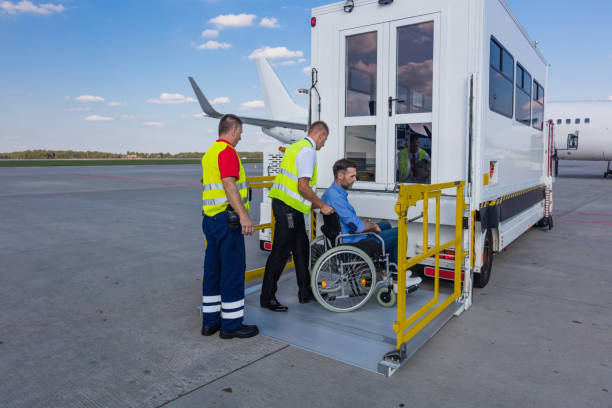
Introduction
Accessible travel for people with disabilities has become an essential aspect of the tourism industry in recent years. With an increasing number of individuals with disabilities around the world, it is critical for the travel sector to make necessary accommodations and ensure that everyone can experience the joys of travel equally.
However, for people with disabilities, travel can be a daunting and challenging experience due to the various barriers they face.
• Explanation of the importance of accessible travel:
Accessible travel is important because it promotes inclusivity and allows individuals with disabilities to have the same opportunities to explore and experience new places as everyone else. It also helps to break down societal barriers and promote understanding and acceptance of people with disabilities.
• Overview of the challenges that people with disabilities face when traveling:
Traveling with a disability can be challenging due to various barriers such as inaccessible transportation, lack of information about accessible accommodations, limited accessibility at tourist destinations, and attitudinal barriers. These challenges can cause physical, emotional, and financial strain on travelers with disabilities.
• Purpose and scope of the guide:
The purpose of this guide is to provide essential information and practical tips to help people with disabilities plan and enjoy accessible travel experiences. It covers various aspects of accessible travel, including researching accessible travel destinations, finding accessible accommodations, and transportation options, packing essentials, navigating airports and security, and enjoying accessible activities and attractions. This guide is intended for people with disabilities, their families, and caregivers to help them plan and enjoy safe, comfortable, and memorable trips.
Planning Your Accessible Trip
Planning an accessible trip requires a bit more research and preparation than a typical trip. Below are some key considerations to keep in mind when planning your trip:
• Researching travel destinations for accessibility:
Not all destinations are created equal in terms of accessibility. Some may have more wheelchair ramps or accessible bathrooms than others, for example. Researching your destination ahead of time can help ensure that you choose a location that meets your accessibility needs.
• Tips for finding accessible accommodations:
Finding accommodations that meet your accessibility needs can be challenging, especially if you have specific requirements, such as an accessible bathroom or roll-in shower. Online booking sites often have accessibility filters that can help you narrow down your options.
• Transportation options for people with disabilities:
Depending on your destination, transportation options may be limited. Researching accessible transportation options, such as accessible taxis or wheelchair-accessible buses, can help you get around more easily.
• Considerations for accessible travel with service animals:
If you are traveling with a service animal, it’s important to research the destination’s policies on service animals ahead of time. Some countries, for example, may have strict requirements for bringing animals across borders. It’s also a good idea to make sure that your accommodations and transportation options are pet-friendly.

Best destinations for travel for people with disabilities
There are many destinations around the world that are particularly welcoming to people with disabilities and offer a range of accessible travel options. Here are some of the best destinations for travel for people with disabilities:
- Amsterdam, Netherlands: Amsterdam has a reputation as one of the most accessible cities in Europe, with excellent public transportation and many wheelchair-friendly attractions.
- Sydney, Australia: Sydney has made significant efforts to become more accessible in recent years, with many of its major attractions now offering accessible facilities.
- Vancouver, Canada: Vancouver is consistently rated as one of the most accessible cities in North America, with a range of accessible transportation options and attractions.
- Barcelona, Spain: Barcelona is known for its beautiful architecture and world-class museums, many of which are wheelchair accessible.
- San Diego, USA: San Diego is home to many attractions that are accessible to people with disabilities, including the famous San Diego Zoo.
- Dublin, Ireland: Dublin is a charming city with many accessible attractions, including the historic Trinity College and the famous Guinness Storehouse.
- Tokyo, Japan: Tokyo has made significant efforts to become more accessible in recent years, with wheelchair-friendly transportation options and many accessible attractions.
- Berlin, Germany: Berlin has a reputation as one of the most accessible cities in Europe, with many wheelchair-friendly attractions and an excellent public transportation system.
- Orlando, USA: Orlando is home to many accessible theme parks, including Disney World and Universal Studios, as well as many other accessible attractions.
Preparing for Your Trip
When traveling with a disability, proper preparation can make all the difference in having an enjoyable and stress-free trip. Here are some tips for preparing for your accessible trip:
• Packing essentials for people with disabilities:
When packing for your trip, make sure to include all essential items that you might need during your journey. This may include medications, mobility aids such as canes or walkers, and any assistive devices such as hearing aids or communication devices.
• Medication and health considerations for travel:
If you require medication, make sure to pack enough for the duration of your trip, plus a little extra in case of unexpected delays. It’s also a good idea to bring a copy of your prescription and a list of all medications you are taking in case of emergency. Consider any health conditions that may require special attention, and make arrangements as necessary.
• Tips for traveling with mobility aids:
If you use a mobility aid such as a wheelchair or scooter, make sure to contact your airline or transportation provider in advance to arrange for any necessary accommodations. It’s also important to check the accessibility of your destination and any activities you plan to participate in to ensure they can accommodate your mobility aid.

Navigating Airports and Security
Traveling through airports can be challenging for anyone, but for people with disabilities, it can be even more difficult. This section provides tips for navigating airport terminals, an overview of TSA security procedures and accommodations, and special considerations for traveling with mobility aids and medical equipment.
• Tips for navigating airport terminals:
- Contact the airport in advance to request assistance and accommodations
- Use airport maps and mobile apps to plan your route and find accessible facilities
- Allow plenty of time for check-in, security screening, and boarding
- Wear comfortable clothing and footwear, and dress in layers in case of temperature changes
- Pack light and bring only what you need for your trip to minimize the weight and size of your luggage
• Overview of TSA security procedures and accommodations:
- TSA has established guidelines and procedures for screening passengers with disabilities
- Screening can include metal detectors, full-body scanners, pat-downs, and inspection of mobility aids and medical equipment
- Passengers with disabilities can request accommodations such as a private screening, assistance with getting through security, and assistance with medication and medical devices
- Passengers can request a TSA notification card or medical documentation to help communicate their needs to TSA personnel
• Special considerations for traveling with mobility aids and medical equipment:
- Check with your airline in advance to ensure that your mobility aid or medical equipment can be accommodated on the flight
- Bring any necessary documentation or prescriptions for your mobility aid or medical equipment
- Label your equipment with your name and contact information in case it gets separated from you during the trip
- Consider purchasing travel insurance to cover the cost of any damage or loss to your equipment during the trip
By following these tips and guidelines, travelers with disabilities can navigate airports and security screening with greater ease and confidence.

Enjoying Your Accessible Vacation:
Traveling with a disability doesn’t have to mean missing out on all the fun. With careful planning and research, there are many ways to enjoy an accessible vacation. This section provides tips and resources for making the most of your travels.
• Tips for enjoying activities and attractions with disabilities:
Traveling can be an enriching and fulfilling experience for everyone, including people with disabilities. There are many activities and attractions that can be enjoyed while traveling, regardless of one’s physical abilities. Here are some tips for enjoying activities and attractions with disabilities while traveling:
- Research: Before traveling to a new destination, research the available activities and attractions in the area. Look for places that are accessible and have accommodations for people with disabilities. Check if there are any mobility aids or equipment available for rent, such as wheelchairs or scooters.
- Plan ahead: When planning your itinerary, consider the amount of physical activity required for each activity or attraction. If necessary, spread out the activities over a few days to avoid exhaustion or overexertion.
- Communicate with staff: When arriving at an activity or attraction, communicate with the staff about any specific accommodations or assistance that you may require. Many places have trained staff or volunteers who can assist with mobility or sensory impairments.
- Adapt activities: Many activities can be adapted to accommodate different abilities. For example, hiking trails can be modified with ramps or graded slopes to make them accessible for people with mobility impairments. Museums and attractions can offer audio guides or touch exhibits for people with visual or hearing impairments.
- Seek out accessible tours: There are many companies that offer accessible tours and activities specifically designed for people with disabilities. These tours may include transportation and guides who are trained to work with people with different abilities.
• Accessibility considerations for dining and nightlife:
When traveling, dining out, and experiencing the nightlife of a new location can be a fun and exciting part of the journey. However, for people with disabilities, there may be additional accessibility considerations to keep in mind. Here are some things to consider:
- Research accessible dining options: Before arriving at your travel destination, research accessible dining options in the area. Look for restaurants with accessible entrances, seating, and restrooms. Many restaurant review websites or apps allow you to filter by accessibility features.
- Make reservations: When making dining reservations, let the restaurant know of any specific accommodations you may need, such as a table with more space for a wheelchair or service animal.
- Communication with restaurant staff: When dining out, communicate with the restaurant staff about any accommodations you may need, such as braille menus, assistance with cutting food, or additional lighting. Don’t be afraid to ask questions or make requests.
- Pack necessary equipment: When planning your trip, make sure to pack any necessary equipment for dining and nightlife. This could include items like assistive devices, communication devices, or hearing aids.
• Resources for accessible travel tours and packages:
For those who prefer to travel with a group or book a pre-planned vacation package, there are many accessible travel companies that specialize in creating customized trips for people with disabilities. These companies can provide accommodations, transportation, and accessible activities and attractions.
By considering accessibility needs and researching ahead of time, people with disabilities can fully enjoy their vacation experiences.

Benefits of accessible travel for people with disabilities
Accessible travel refers to the practice of providing equal opportunities for people with disabilities to travel, explore and experience different destinations, just like everyone else. There are numerous benefits of accessible travel for people with disabilities. In this section, we will discuss some of these benefits:
- Improved Quality of Life: Accessible travel allows people with disabilities to participate in activities and enjoy experiences that they may have been deprived of due to the lack of accessibility in the past. This can lead to an improved quality of life, as individuals are able to engage in leisure activities and social interactions that promote personal growth and mental well-being.
- Increased Independence: Accessible travel can help people with disabilities to become more self-sufficient and independent. By providing accessibility features such as wheelchair ramps, audio guidance, and Braille signage, people with disabilities are able to navigate through unfamiliar places with greater ease, and are more likely to take on new challenges and explore new environments on their own.
- Enhanced Accessibility Awareness: The growth of accessible travel has also led to increased awareness of accessibility issues in the tourism industry, as well as among the general public. This can help to promote a more inclusive and accessible society, where people with disabilities are treated with respect and dignity.
- Boosting Local Economies: Accessible travel can also have a positive impact on local economies. By providing accessible facilities and services, destinations can attract a wider range of tourists, including those with disabilities. This can help to increase revenue for local businesses, create jobs, and stimulate economic growth.
- Building Stronger Communities: Accessible travel can also help to build stronger communities, by promoting interaction and understanding between people with disabilities and those without. By breaking down barriers and increasing accessibility, people with disabilities can feel more included and connected to their communities.
Accessible travel has many benefits for people with disabilities, from improving their quality of life to promoting accessibility awareness and building stronger communities. It is important for the tourism industry to continue to develop and implement accessibility features, in order to ensure that people with disabilities can fully participate in and enjoy travel experiences.

Overcoming common barriers to accessible travel
Overcoming common barriers to accessible travel is crucial for making travel more inclusive for people with disabilities. While there have been significant improvements in accessible travel, there are still many barriers that can make it difficult for people with disabilities to travel comfortably and safely. Some of the common barriers that need to be overcome include:
- Lack of information: One of the biggest barriers to accessible travel is the lack of information about accessibility at travel destinations. It can be difficult for people with disabilities to find reliable information about accessibility, such as whether accommodations and attractions are wheelchair accessible or whether public transportation is accessible.
- Physical barriers: Physical barriers can make it difficult for people with disabilities to access public transportation, accommodations, and attractions. Examples of physical barriers include stairs, narrow doorways, and uneven surfaces.
- Negative attitudes and stereotypes: Negative attitudes and stereotypes about people with disabilities can be a significant barrier to accessible travel. People with disabilities may face discrimination, stigmatization, and prejudice when trying to access accommodations, attractions, and transportation.
- Cost: Travel can be expensive, and the cost of accessible travel can be even higher due to the need for specialized accommodations, transportation, and equipment. This can make travel inaccessible for many people with disabilities.
- Lack of accessible transportation: Accessible transportation is essential for accessible travel, but many destinations do not have adequate public transportation that is accessible to people with disabilities. This can limit the ability of people with disabilities to travel to and from destinations.

Future of accessible travel: Innovations and improvements
Accessible travel has come a long way, but there is still a lot of work to be done to improve the travel experience for people with disabilities. Fortunately, there are many innovations and improvements being developed and implemented that hold promise for the future of accessible travel. This article will explore some of these innovations and improvements and what they mean for travelers with disabilities.
- Smart luggage: Luggage with built-in GPS tracking and electronic locks can help travelers with disabilities keep track of their belongings and prevent theft.
- Better wheelchair design: Innovations in wheelchair design can make them more lightweight, maneuverable, and comfortable, making travel easier and more enjoyable.
- Assistive technology in hotels: Hotels are starting to incorporate assistive technology, such as smart mirrors and voice-activated controls, to make their rooms more accessible.
- Inclusive tour packages: Tour packages that are specifically designed for people with disabilities can make travel more convenient and enjoyable.
- Accessible travel insurance: More options for accessible travel insurance can provide peace of mind for travelers with disabilities.
- Innovative communication tools: Communication tools that incorporate speech-to-text and text-to-speech technology can help people with disabilities to communicate more effectively while traveling.
- Accessible travel apps: Travel apps that incorporate accessibility features, such as audio descriptions and voice navigation, can make travel easier and more enjoyable for people with disabilities.
- Increased awareness: Increased awareness of accessibility issues and the importance of inclusive travel can lead to more improvements and innovations in the future.
Conclusion
In conclusion, accessible travel is important for people with disabilities to have the opportunity to explore and experience the world just like anyone else. Despite the challenges that come with traveling with a disability, proper planning and preparation can make it possible. This guide has provided helpful tips and resources for planning and enjoying an accessible trip, from researching accessible destinations and accommodations to navigating airports and enjoying activities and attractions.
It is hoped that this guide will inspire and empower individuals with disabilities to pursue their travel dreams and provide helpful insights for their families, caregivers, and travel industry professionals. Remember that everyone deserves to explore the world and create memorable experiences, regardless of their abilities.
Read more article here.





